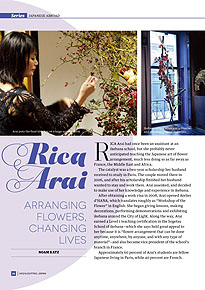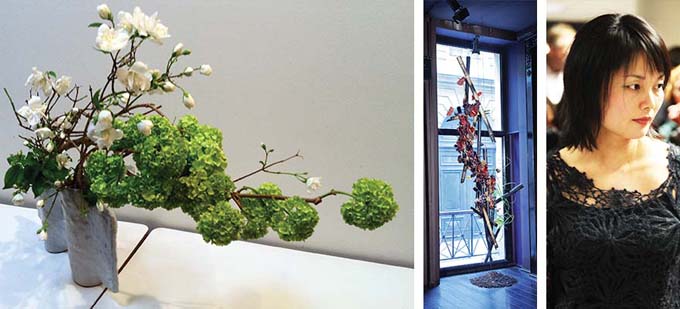Home > Highlighting JAPAN >Highlighting Japan October 2014> Japanese Abroad
Highlighting JAPAN

Japanese Abroad
Rica Arai
Arranging Flowers, Changing Lives

Rica Arai had once been an assistant at an ikebana school, but she probably never anticipated teaching the Japanese art of flower arrangement, much less doing so as far away as France, the Middle East and Africa.
The catalyst was a two-year scholarship her husband received to study in Paris. The couple moved there in 2006, and after his scholarship finished her husband wanted to stay and work there. Arai assented, and decided to make use of her knowledge and experience in ikebana.
After obtaining a work visa in 2008, Arai opened Atelier d’HANA, which translates roughly as “Workshop of the Flower” in English. She began giving lessons, making decorations, performing demonstrations and exhibiting ikebana around the City of Light. Along the way, Arai earned a Level 1 teaching certification in the Sogetsu School of ikebana—which she says held great appeal to her because it is “flower arrangement that can be done anytime, anywhere, by anyone, and with any type of material”—and also became vice president of the school’s branch in France.
Approximately 60 percent of Arai’s students are fellow Japanese living in Paris, while 40 percent are French. “Generally, the French tend to think of ikebana as a traditional Japanese art, while those who know ikebana see it as having both elements of traditional culture and contemporary art,” she notes.
Eight years of experience in France has also helped Arai perceive differences between Japanese and French ideas regarding the aesthetics of beauty. “They are completely different,” Arai believes. “French people value symmetry, for example, whereas Japanese tend to prefer a degree of asymmetry in their arrangements.” Consequently, Arai has recently observed a growing French boom in using longer-stemmed flowers that were traditionally used in ikebana, as evidenced by the fact that more French florists are offering such flowers.
While Arai has traveled to countries other than France such as Saudi Arabia to give ikebana demonstrations and inspire others about her art, the inspiration sometimes happens in reverse. In February 2010, the Japan Foundation asked Arai to visit Sudan to teach ikebana to the people there. However, prior to departure she was under the impression that Sudan lacked the necessary teachers, flowers and knowledge of ikebana.
But whatever the Sudanese may have lacked in knowledge and materials, they made up for with an unmatchable love of flowers and flower arrangement. “Even though they were not accustomed to arranging ikebana, I still got a strong sense of their desire to arrange flowers,” Arai recalls. “They were so passionate. I’d always thought it would be nice if ikebana spread around the world, and after this experience I really felt my mission was to be a part of that.”
Nearly seven years have passed since Arai first began teaching in Paris, and the ikebana instructor says she’s pleased that her students have become quite proficient.
At the moment, Arai has aspirations to hold an exhibition in Paris showing her own creations. Yet reflecting on her experience in Sudan, she also dreams of working in Africa and helping ikebana take root all around the world. It’s clear that Arai’s activities with ikebana will continue to flourish and change lives.
© 2009 Cabinet Office, Government of Japan






